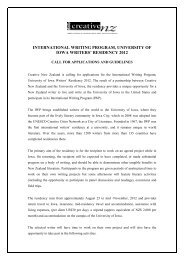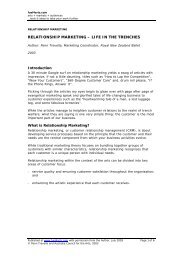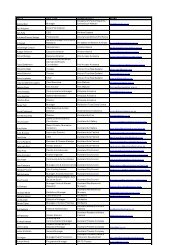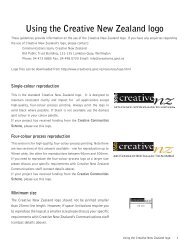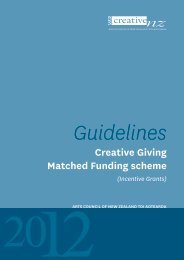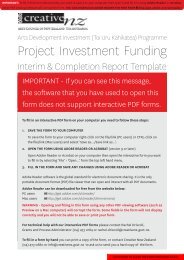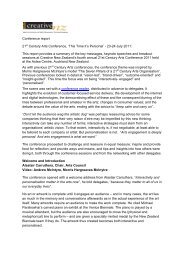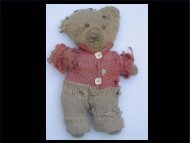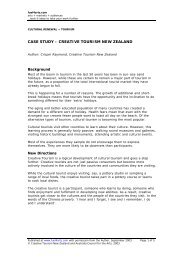Smart Arts - Creative New Zealand
Smart Arts - Creative New Zealand
Smart Arts - Creative New Zealand
- No tags were found...
You also want an ePaper? Increase the reach of your titles
YUMPU automatically turns print PDFs into web optimized ePapers that Google loves.
4WATCHTHEHYPEBe sure your show candeliver what you promiseand be wary of hype.Thepublic certainly is. Nomatter how good yourshow is and no matter howmuch your audience enjoysit, they will leavedisappointed if it doesn’tdeliver what you promise.Unwarranted hype mayhelp you achieve anaudience in the short-termbut the damage to yourreputation and credibilitywill be long-lasting.The underlying message you would use to target social clubs via direct mail could be:“For a fun night out with your colleagues, don’t miss this hilarious comedy.”With the first message, you’re trying to create a sense of urgency and playing on people’sflocking mentality. With the second message, you’re aiming to satisfy a perceived need.Both these statements carry the same key message that what you are selling are laughs.The tag lineDeveloping a tag line, or catchphrase, is a good way to get across your core message.The core of your message – “laughs” in the above example – and how you convey thatmessage become your brand.A tag line sums up the experience to a potential audience member. When a tag line is acritic’s quote, it adds credibility and comes across as information rather than advertising.When you’re devising a tag line, choose something descriptive but avoid clichés. If youcan’t come up with an expressive tag line, then use a straightforward descriptive one.For the women’s dance show (page 10), it is more effective for the tag line to be alongthe lines of “<strong>New</strong> <strong>Zealand</strong>’s funkiest contemporary women dancers” than “fast, furiousand funny”.The second tag line is playful but doesn’t say much to someone unfamiliar with thecompany’s work. A good tag line can combine both information and fun but it needs toconvey your message clearly.For the theatre example (page 10), the tag line needs to reflect the cross-cultural andcollaborative nature of the production. “When love crosses cultures – Mäori and Pasifika”will appeal to both Mäori and Pacific markets.Working with your sponsorsHow to attract and maintain sponsors is a book in its own right. However, it’s important torealise that sponsorship is a partnership arrangement offering mutual benefits to both parties.Factor in ways of working with your sponsors from the outset of your marketing strategy.Achieving cash sponsors can be time-consuming and needs a lot of lead-in. Obtaining“contra” sponsorship is easier. This is where you get goods or services in return foracknowledgement through branding and complimentary tickets. It’s essential to knowyour target markets and align a potential sponsor’s target market with yours.Think about the areas where you need to spend money: e.g. printing flyers. Is theresomeone in your team who has an existing relationship with a printer? Is there somethingabout your show that may help you approach a particular printer? Instead of asking theprinter to pay for the entire job, you could ask a lithographer to cover the cost of thefilms and a paper company to cover the paper costs.Take good care of your sponsors. Make sure your sponsors sign off any print material thathas their logo on it. Touch base with them and give them updates on your progress.Meet and greet them when they attend your event. Put everything in writing and be sureto deliver what you promise. At the end of your event write them a report on how youdid, supplying press clippings and print examples of where their logo appeared, and thank<strong>Smart</strong> arts | Toi huatau28



